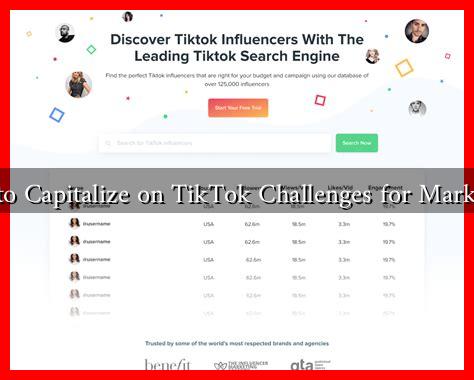-
Table of Contents
- How to Capitalize on TikTok Challenges for Marketing
- Understanding TikTok Challenges
- Why TikTok Challenges Matter for Marketing
- Steps to Create a Successful TikTok Challenge
- 1. Identify Your Target Audience
- 2. Develop a Creative Concept
- 3. Collaborate with Influencers
- 4. Promote Your Challenge
- 5. Engage with Participants
- Case Studies: Successful TikTok Challenges
- Conclusion
How to Capitalize on TikTok Challenges for Marketing
In the ever-evolving landscape of social media, TikTok has emerged as a powerhouse platform, particularly among younger audiences. With its unique format and engaging content, TikTok challenges have become a viral phenomenon, offering brands an innovative way to connect with consumers. This article explores how businesses can effectively leverage TikTok challenges for marketing purposes, providing actionable insights and real-world examples.
Understanding TikTok Challenges
TikTok challenges are user-generated content trends that encourage participants to create videos based on a specific theme, song, or action. These challenges often go viral, leading to widespread participation and engagement. For marketers, this presents a unique opportunity to tap into the creativity and enthusiasm of TikTok users.
Why TikTok Challenges Matter for Marketing
Engaging with TikTok challenges can significantly enhance a brand’s visibility and connection with its audience. Here are some reasons why:
- High Engagement Rates: TikTok boasts an average engagement rate of 17%, far surpassing other social media platforms.
- Viral Potential: A well-executed challenge can reach millions of users in a short time, amplifying brand awareness.
- Authenticity: User-generated content fosters a sense of community and authenticity, making brands appear more relatable.
Steps to Create a Successful TikTok Challenge
To effectively capitalize on TikTok challenges, brands should follow these strategic steps:
1. Identify Your Target Audience
Understanding your audience is crucial. Analyze the demographics of TikTok users and tailor your challenge to resonate with their interests and preferences. For instance, if your target audience is Gen Z, consider trends that align with their values, such as sustainability or social justice.
2. Develop a Creative Concept
Your challenge should be fun, engaging, and easy to participate in. Here are some ideas:
- Dance Challenges: Create a unique dance routine set to a catchy song.
- Transformation Challenges: Encourage users to showcase a before-and-after transformation related to your product.
- Storytelling Challenges: Invite users to share personal stories that connect with your brand’s message.
3. Collaborate with Influencers
Partnering with TikTok influencers can amplify your challenge’s reach. Influencers have established trust with their followers, making them effective brand ambassadors. For example, when the skincare brand CeraVe collaborated with influencers for their #CeraVeChallenge, they saw a significant increase in brand awareness and product sales.
4. Promote Your Challenge
Utilize various marketing channels to promote your TikTok challenge:
- Social Media: Share teasers and updates on your other social media platforms.
- Email Marketing: Inform your existing customers about the challenge through newsletters.
- Paid Advertising: Consider using TikTok Ads to reach a broader audience.
5. Engage with Participants
Interaction is key to maintaining momentum. Respond to participants, share their videos, and create a sense of community around your challenge. This not only encourages more participation but also builds brand loyalty.
Case Studies: Successful TikTok Challenges
Several brands have successfully leveraged TikTok challenges to boost their marketing efforts:
- Chipotle’s #GuacDance: This challenge encouraged users to showcase their dance moves while celebrating National Avocado Day. It resulted in over 1 million video submissions and a significant increase in guacamole sales.
- Ocean Spray’s #DreamsChallenge: When Nathan Apodaca posted a video of himself skateboarding while drinking Ocean Spray cranberry juice, it sparked a viral challenge that led to a 500% increase in sales for the brand.
Conclusion
Capitalizing on TikTok challenges can be a game-changer for brands looking to enhance their marketing strategies. By understanding your audience, creating engaging content, collaborating with influencers, and actively promoting your challenge, you can harness the power of TikTok to drive brand awareness and customer engagement. As the platform continues to grow, staying ahead of trends and adapting your strategies will be essential for success.
For more insights on leveraging social media for marketing, check out Social Media Examiner.

